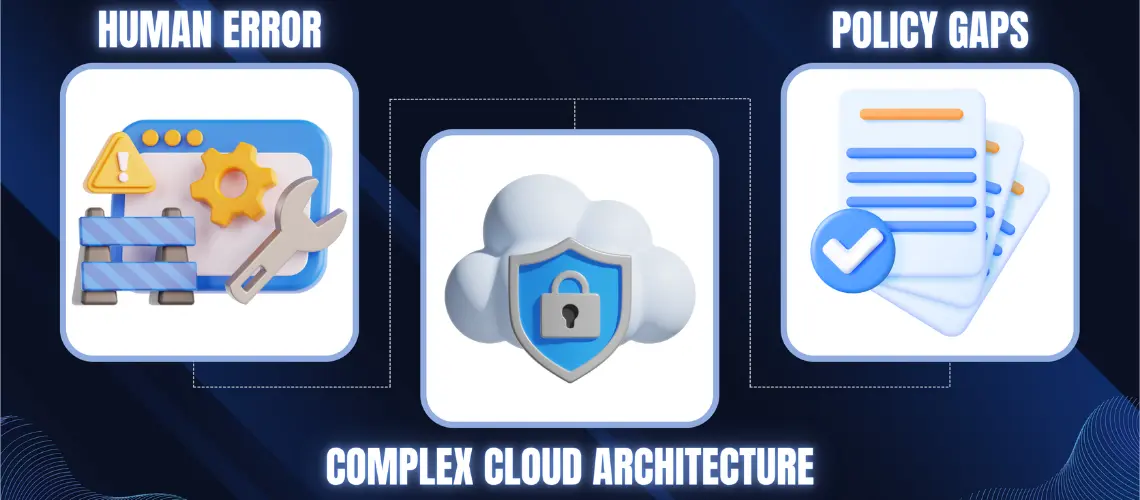
Cloud misconfiguration may expose sensitive data
As businesses are adopting cloud technology and cloud services at record speed, cloud security misconfigurations have become one of the biggest threats in modern cloud computing. Many of these assaults can be attributed to cloud security misconfigurations, which typically happen when developers alter infrastructure without fully comprehending the ramifications...
Hidden Cloud Security Misconfigurations & How To Prevent Them
Any bugs, gaps, or mistakes that could put your infrastructure at risk during cloud adoption are referred to as cloud misconfiguration. These online dangers can take the shape of ransomware, malware, security lapses, outside hackers, or insider threats that gain access to your network by exploiting weaknesses. Because multi-cloud settings can be complex and it can be difficult to identify and manually correct errors, misconfiguration in cloud computing is a concern. This is challenging since cloud misconfiguration problems, such as cloud leaks, cannot be fixed once. Nonetheless, putting security protocols in place during the building phase would be beneficial. DevOps and security teams must therefore cooperate.
1. Data breaches: One of the most alarming concerns associated with incorrect cloud
installations is, of course, data breaches. Sensitive information may leak if your network security, access
control, or cloud storage settings aren't set up correctly. Data breaches can result in the theft of
employee information, financial transfers, and personal customer information.
2. Financial Losses: Cloud security misconfigurations frequently result in financial losses
for organizations. Time and resources are wasted looking into data breaches. If data protection laws are not
appropriately observed, there may be fines and penalties. When services are sluggish or unavailable, sales
fall. Lawsuits are often filed by customers whose data has been stolen.
3. Legal and Compliance Issues: Strict data protection regulations must be followed by many
industries. Unauthorized access to data can result from improperly designed clouds, and data breaches can
quickly put you in legal hot water. The following consequences are likely to occur: mandatory audits and
oversight, legal action from impacted parties, government fines and penalties, and case studies of cloud
misconfiguration. Misconfigurations in the cloud frequently result in data breaches.
1. Unlimited Outbound Access: When you have unlimited internet access, malicious actors can
use your lack of workload protection and outbound limits to steal data from your cloud platforms. Limiting
your cloud instances to particular IP addresses and cloud services will stop hackers from accessing and
stealing your data.

Unlimited outbound access increases the risk of unauthorized data exfiltration
2. Disabled Logging: The detection of malicious threat actor behavior depends on the
efficient data logging of cloud security events. However, logging is frequently turned off by default on
cloud platforms or turned off to save the burden associated with keeping logs. There is no record of events
if logging is turned off, making it impossible to identify possibly harmful activities or occurrences. As a
best practice, logging should be enabled and controlled.
3. Missing Alerts: The majority of cloud providers and all cloud security posture
management providers detect unusual or probably malicious activity and send out alerts for significant cloud
security misconfigurations. Sadly, defenders frequently overlook these notifications because of either too
much low-relevance information (alert fatigue) or a simple disconnect between the alert sources and the
locations where they search for alerts, such as a SIEM.
4. Exposed Access Keys: As a security principle, access keys are utilized to communicate
with the cloud service plane. Threat actors may demand a ransom in exchange for a pledge not to sell or leak
the data, and exposed keys can be quickly exploited by unauthorized parties to steal or erase data. Although
it is possible to keep these keys private, it is preferable to employ automatically rotating short-lived
access keys or to restrict their use (from which IP addresses and networks) in conjunction with these
measures.
5. Excessive Permissions: The majority of accounts (roles, services) have a slightly larger
set of sporadic operations and a smaller set of regular operations. The "blast radius" is overly large when
they are granted considerably more rights than are necessary and abused by a threat actor. The effects of
data exfiltration, destruction, and code tampering might worsen when lateral movement, persistence, and
privilege escalation are made possible by excessive permissions.
6. Ineffective Identity Architecture: The existence of user accounts not based on a single
identity provider that enforces limited session times and multifactor authentication (MFA) and has the
ability to flag or block sign-in for irregular or high-risk signing activity is a major contributor to cloud
misconfiguration breaches due to the high risk of stolen credentials.
7. Inadequate Network Segmentation: and other antiquated, laborious procedures are rendered
obsolete by contemporary cloud network concepts like network security groups. But because of the underlying
design presumption that "inside the network is safe" and "front-end firewalls are all that is needed,"
inadequate security group management techniques can foster an environment in which adversaries can readily
migrate between hosts and services. Cloud defenders lose the opportunity to prevent most breaches involving
cloud-based endpoints by failing to use security group features that allow only host groups that require
communication to do so and block unnecessary outbound traffic.
8. Improperly Configured Public Access: Sensitive data can be exfiltrated or deleted
quickly if a cloud storage bucket, a vital network service like SSH, SMB, or RDP, or even a web service that
wasn't meant to be public, is made publicly accessible.Improperly configured public access makes cloud
storage buckets vulnerable to cyberattacks.

Improperly configured public access makes cloud storage buckets vulnerable to cyberattacks
9. Public Images and Snapshots: It is uncommon for a machine image (template) or volume snapshot to be inadvertently made public. When it occurs, it gives opportunistic adversaries the opportunity to gather private information from that public persona. Passwords, keys, certificates, and API credentials may occasionally be included in that data, which could result in a more serious cloud platform compromise.
There are multiple things that can cause a cloud misconfiguration, and you need to know what they are if
you’re going to prevent and resolve them in the future.
1. Human Error
Simple mistakes that even specialists can make, as well as a lack of information and experience, are the
main causes of human errors. Among the most common mistakes are those made by cloud administrators or
developers who type something incorrectly, set parameters incorrectly, or neglect to activate the required
security settings. Note that the speed of cloud computing and the constant changes to programs and cloud
services significantly increase the security misconfiguration risk.
2. Insufficient Experience
Cloud technology is extremely complicated and changing quickly. This indicates that a large number of
businesses lack a knowledgeable staff that is fully conversant with the cloud. A critical number of
cloud-related misconfigurations occur because teams frequently don't even know what kinds of changes they
need to make to the cloud systems.
3. Intricate Cloud Architecture
Modern cloud architecture is incredibly complicated because of the vast array of services, virtual
assistants, technologies, etc. Maintaining and securing setups across all components is challenging due to
this complexity. Therefore, as the number of cloud services increases, so does the likelihood of
misconfigurations.

Misconfiguration risks in cloud computing
4. Inadequate Policy Management and Governance
The most frequent causes of cloud security misconfigurations are inadequately specified policies and
procedures, as well as a lack of governance. If your company doesn't perform annual system audits, you
should expect that misconfigurations that you haven't even seen yet will have accumulated. Preventing cloud
security misconfigurations involves a variety of technical and human-related best practices.
1. Putting IAM Policies into Practice
It is crucial to adhere to the least privilege principle and make sure that a user or service using the
cloud has no more rights than necessary in order to minimize cloud security misconfigurations. Furthermore,
multifactor authentication is enabled, and passwords are strengthened to lessen the likelihood that any IAM
actor will have illegal access. Cloud security analysis and auditing user and service permissions to remove
superfluous rights, businesses, and their human services may help create a secure IAM environment.
2. Frequent Penetration Tests and Security Audits
Organizations can identify and promptly fix cloud misconfigurations by conducting regular security audits.
Penetration testing mimics the actions of attackers in order to find and take advantage of undiscovered
cloud vulnerabilities brought on by organizational cloud misconfigurations.
3. Making Use of Tools and Automation
Best practices for minimizing human error in cloud security misconfigurations and ensuring uniformly
structured setups across cloud solutions include automation and the use of appropriate security
technologies. Infrastructure as code (IaC) technologies help automate compliance checks and standardize
repetitive infrastructure deployment procedures.

Ensure strong protection against cloud security misconfigurations
While there are many advantages to modern cloud security solutions, there are also new vulnerabilities. One of the most urgent issues is the difficulty of determining when a solution is lacking a feature upgrade or is not responsive to new vulnerabilities. Understanding the ramifications of employing these tools is essential to protecting your business. The factor of human mistakes can cause even the finest cloud security mechanisms to fail. For optimal outcomes, security automation must be paired with human understanding. To lower the risk of common cloud misconfigurations, firms should implement best practices such as appropriate IAM policies, frequent security audits, and employee training.
Cloud security explanations include errors or vulnerabilities resulting from incorrectly configured security settings or the absence of essential security configurations in systems, applications, or networks.
Cloud computing security faces various challenges, including data breaches, misconfigurations, unauthorized access, and the complexity of managing identities and access in distributed environments.
Examples include using default passwords, leaving unnecessary ports open, failing to apply security patches, or improperly configured access controls.
Azure misconfiguration refers to errors or inconsistencies in how Azure cloud resources are set up and secured.
Amazon Cognito handles user authentication and authorization for your web and mobile apps.